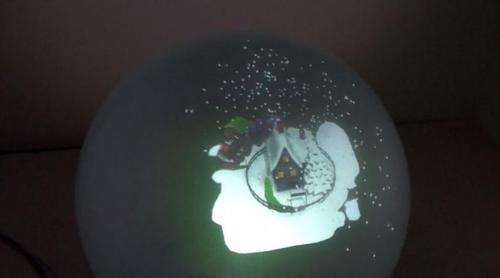August 26, 2014 weblog
Team shows calibrated multiple-projector spherical display

Researchers from Canada and Brazil offer designers a hard-to-resist invitation—a spherical display that lets you use gestures to interact with three-dimensional display objects. Their formal description is "A 3D perspective-corrected interactive spherical scalable display." Attendees at SIGGRAPH 14 in Vancouver had a close-up look at. the device called Spheree. A detailed report on their work in IEEE Spectrum on Sunday called out its significance, representing "the first display capable of projecting uniform, high resolution pixels on a spherical surface."
The team said, "calibrated multiple-projector spherical displays represent a future of interactive, scalable, high-resolution, non-planar displays." A demo in their video includes a Snow Globe 3D animation, in a popular winter seasonal image, which is a house, snow and a train moving around the house. "In one demonstration, viewers have the sensation of staring into a snow globe that they can control with simple gestures from any angle," said IEEE Spectrum.
The technology involved includes miniprojectors at the base of the globe and software blending individual projector views. The result, from almost anywhere on the spherical surface, was a uniform pixel presentation. The team said they used multiple, automatically calibrated and blended miniprojectors to create the uniform pixel space on the surface of the sphere.
Their auto-calibration algorithm is called FastFusion. They get a seamlessly combined resolution and brightness of the many projected images without losing quality. Also, said IEEE Spectrum, "A basic webcam allows the algorithm to see the position of the individual projector images on the globe and compute each image's contribution to the overall final image."
Spheree is scalable; one could build larger versions of Spheree; it can be assembled in different sizes allowing for as many projectors as needed. The creators, from the University of Sao Paulo and University of British Columbia, explained the two ways of handling Spheree. One way is with a hand-track device for interactions calling for precise pointing. This approach would be suited for sculpting applications. The second way is using both hands with bimanual gestures. The researchers said the device supports tangible interactions such as moving, rotating, sculpting, and painting objects, in addition to object manipulation.
"Spheree also uses six infrared cameras to track the movement of special headbands worn by viewers. The data the cameras feed to a computer constantly provide perspective-corrected virtual scenes based on a viewer's position with respect to the globe," said IEEE Spectrum. A Leap Motion interface for gesture control allows user interactions with the 3-D scenes or animations by using gestures to start, go forward and back, pause and stop animations.
Spheree also gets interesting in the way it allows for collaborative design with a companion desktop application.
IEEE Spectrum noted "the system uses a second computer to run 3-D animations with Blender Software. Researchers envision Spheree helping animators or modelers by showing 3-D computer animations or the results of image-based rendering applications—perhaps as a second screen."
More information: s2014.siggraph.org/attendees/e … nteractive-spherical
© 2014 Tech Xplore


















